
The Siemens-Schuckert D-IV outstanding WWI German Scout
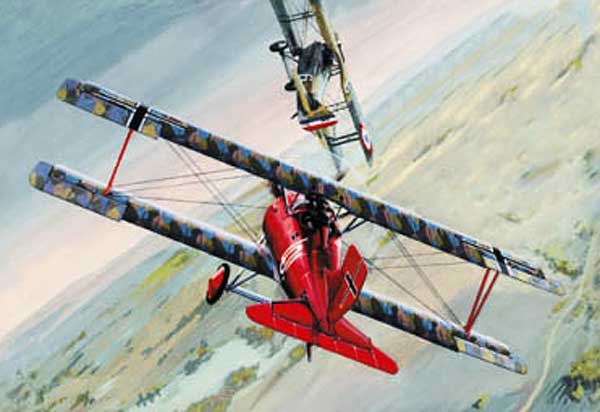
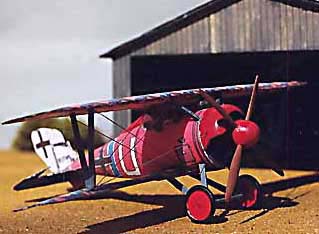
On this late WWI German fighter, the rotary engine turned the prop as well as the engine giving the engine a lot of torque and the ability to turn a huge propeller (in this case 4 bladed!) and fantastic climb. The 'U' stands for 'Udet" leader of the Jagdstaffeln 14. The motor rotates on this little model.
As A FIGHTING machine, the SS D.IV was as potent as anything developed by the warring nations of WW I. By skillful and sometimes ingenious methods, Siemens engineers produced an airplane weighing no more than its predecessor, the D.III, but, with a reduced wing area and a much higher combat performance, mostly due to a new engine, the 200-hp Siemens Haiske SH.IIIa.
Many experts believe that without this engine the D.IV would have been just another airplane. The engine was unique among rotaries in that...
Siemens-Schuckert D-IV
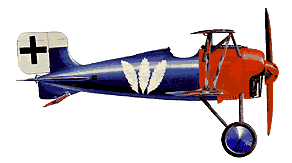
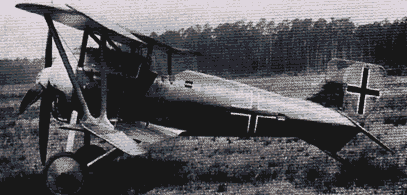 As A FIGHTING machine, the SS D.IV was as potent as anything
developed by the warring nations of WW I. By skillful and sometimes
ingenious methods, Siemens engineers produced an airplane weighing
no more than its predecessor, the D.III, but, with a reduced wing
area and a much higher combat performance, mostly due to a new
engine, the 200-hp Siemens Haiske SH.IIIa. Many experts believe
that without this engine the D.IV would have been just another
airplane.
As A FIGHTING machine, the SS D.IV was as potent as anything
developed by the warring nations of WW I. By skillful and sometimes
ingenious methods, Siemens engineers produced an airplane weighing
no more than its predecessor, the D.III, but, with a reduced wing
area and a much higher combat performance, mostly due to a new
engine, the 200-hp Siemens Haiske SH.IIIa. Many experts believe
that without this engine the D.IV would have been just another
airplane.
The engine was unique among rotaries in that the crankshaft revolved in one direction and the cylinders and crankcase revolved in the opposite direction, thus giving an equivalent engine speed of 1,800 rpm with a propeller speed of 900 rpm, a direct 2-I reduction. This feature allowed the use of a huge four-bladed propeller that was streamlined with a spun aluminum spinner.
From the pilot's standpoint, the Siemens-Schuckert D.IV was an excellent airplane in which to go to war. Its ability to climb rapidly at high altitudes where other aircraft were sluggish was one of its best attributes. lt was easily controlled and very responsive, although according to pilot reports it had a nasty stall.
Because it was produced in the last stages of WW I, it was too late arriving to have much influence over the fate of the Germans.
Siemens-Schuckert began the construction of aircraft in World War I, and its first fighter was the D I modeled on the Nieuport 11, a French machine. Via the D II prototype the manufacturer then moved to a completely German design, ordered late in 1917 as the D Ill equal-span biplane with the 119-kW 1160-hp) Siemens-Halske Sh.Ill rotary engine whose diameter dictated the circular section of the compact fuselage that tapered sharply into the empennage with its large tailplane and angular vertical surfaces.
After the teething problems of this engine had been cured, the 50 D Ills matured as extremely fast-climbing interceptors whose other performance figures were low. The D Ill was followed by the D IV, which introduced much aerodynamic refinement for slightly higher speed and still better climb rate. A total of 280 was ordered, but less than 140 D Vs were completed, most entering service after August 1918.
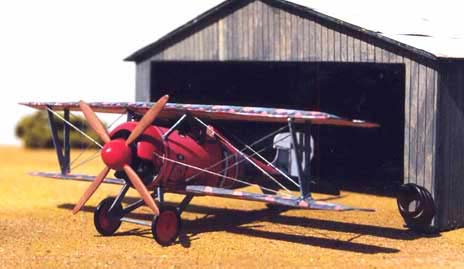 |
|
Another note on the Siemens, it has movable control
surfaces [ shim stock between cardboard.] Dick D |
Although it never achieved the same eminence, the Siemens-Schuckert
fighter was, in terms of power. Maneuverability and rate of climb,
the nearest parallel to the Sopwith Camel produced by the German
aviation industry during 1914-18. In 1917 another member of the
great Siemens combine, the Siemens-Haiske engine works, produced
a new rotary engine, the 11-cylinder Shill, which offered l60 hp.
Under the direction of Dipl. Ing. Harald Wolff three prototype
machines, designated DII, Dila and Dub, were built around this
powerplant and began flight tests in June 1917. 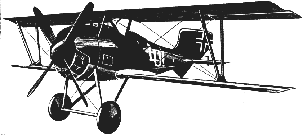
The DII was not outstandingly fast, but it had an excellent climb. Three more development aircraft were ordered, a short-span and a long-span D.IIc and a standard-span DUe. These, completed in October, were later redesignated DIII. Twenty DIIIs were ordered in December 1917, with smaller, 4-blade propellers and shorter undercarriage legs. Delivery began in January 1918; in February thirty more D.IIIs were ordered, and by the end of May delivery to front-line Jasta's, notably Nos. 12 and 15, was almost complete.
The fully cowled ShIII had a tendency to overheat, and in the early summer the DIIIs were returned to the factory for minor airframe alterations and installation of 300 hp Shilla engines. They were returned to service from July onward, having the lower part of the cowling cut away to facilitate cooling. By this time their primary value was as home defense fighters, in which role they were highly successful. Eighty DIIIs were built altogether, serving with Jastas 2. 12, 13, 15, 19, 26, 27 and 36, with five home defense units and one or two training establishments.
Meanwhile the long-span D.IIc had been further refined, and with narrower chord wings became the forerunner of the DIV. The D.IV was faster in level flight and even better in a climb than the DIII, and was ordered in March 1918. It became operational in the following August. An eventual two hundred and eighty DIVe were ordered, but only one hundred and twenty-three were completed. About half of these had reached front-line units (including Jastas 11,14 and 22) by the Armistice. The D.IV was rather tricky to land, but in all other respects was an admirable aeroplane. It had a very short take-off, and at heights above 13, l20 ft was faster and more manoeuvrable than the Fokker DVIII.
Its outstanding feature was its phenomenal rate of climb - it could reach 19,685ft in less than 14 1/2 minutes. As late as October 1918 it was officially described as superior by far to all single-seaters in use at the Front today'. Production of the DIV did not finally end until summer 1919. In 1918 a 2-bay derivative, the DV, participated in the Adlershof trials in May/June, but was not built in quantity.
The D III fighter turned out in late 1917 by the Siemens-Schuckert Werke was designed around the new Siemens-Haiske Sh.III 160-hp rotary engine, which was produced by another division of the company. It was very manoeuvrable and possessed an excellent rate of climb.
The designer was Harald Wolff. who tested three prototypes in June 1917. Further development of the design led to the production version, the D-IV. A first order for 20 planes was placed in December 1917. A total of 80 D-IVs was built. They saw service with eight fighter squadrons and some home defense units, as well as a couple of flying schools.
The best features of this plane were its maneuverability
and rate of climb, and the DIII was a success in combat. The improved
D-IV version came out in August 1918, and was even faster and more
manoeuvrable than the earlier model.
Early in 1917 the Siemens-Schuckert Werke at Siemensstadt, Berlin, produced three experimental fighters the SSW D-II, D-IIa and D-IIb, which were specially designed to utilize the new and promising 160 h.p. Siemens-Halske Sh III eleven-cylinder geared rotary engine.
Flight testing began in June 1917, as soon as the first engines became available, and the experimental machines were found to have phenomenally good rates of climb. After further development work three improved prototypes, the D-IIc short wing, D-IIc long wing and D-IIe, were completed; one of these, the D-IIc long wing (7551/17), was chosen as the prototype of the new SSW D-III fighter.
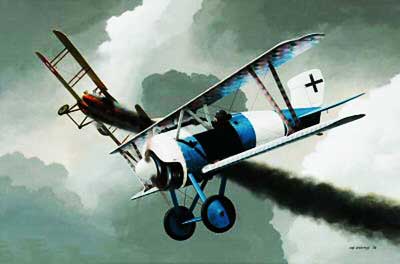 Twenty production D-III's were ordered by IdFlieg in December
1917, while development work was still in progress, and a further
order for thirty more followed in February 1918. The early models
had four-bladed airscrew's with large spinners, large circular
aluminum cowlings, balanced ailerons on both wings, stumpy plywood-covered
fuselages and balanced elevators and rudders.
Twenty production D-III's were ordered by IdFlieg in December
1917, while development work was still in progress, and a further
order for thirty more followed in February 1918. The early models
had four-bladed airscrew's with large spinners, large circular
aluminum cowlings, balanced ailerons on both wings, stumpy plywood-covered
fuselages and balanced elevators and rudders.
In April the first D-III's were supplied to Jagdgeschwader 11 (Hauptmann Berthold) for operational trials. For security reasons it was forbidden to cross the lines in a D-III, but the fighter's great climbing power made it a useful interceptor.
Criticism was, however, leveled at its relatively poor speed in level flight, and trouble was experienced with the Sh III engine, mainly because of poor-quality pistons and inferior oil. A tendency to overheat was rectified by cutting away the lower half of the cowling, a modification which became standard on all subsequent D-III's and D-IV's.
Eventually the first thirty-eight D-III's were withdrawn for refitting at the works, and Jagdgeschwader 11 were reequipped with Fokker D.VII Is. Delivery of the D-III recommenced in July, after the Sh IIIa engine and modified ailerons and rudder had been fitted; this time the type was sent to the Kampfeinsitzer Staffeln (home-defense fighter units) Nos. 4a, 4b, 5, 6, and 8, and Jadgstalselschule (Fighter School) No. 1.
Meanwhile the SSW D-IV was undergoing development; it was hoped to combine the excellent rate of climb of the D-III with a fair turn of speed on the level. The D-IV differed only slightly from the later D-III's; its spinner had four ventilation holes, and its wings, of smaller span and chord, were fitted with ribs of improved section. As supplies became available, the type was delivered to frontline units, including Jagdgeschwader 11, Jagdstaffeln 14 and 22, Kampfeinsitzerstapel 2 and the Marinejagdgeschwader.
In a number of ways the type was superior to the redoubtable Fokker D-VII, and some pilots claimed that it was the best fighter at the front. Major K. L. Caldwell (twenty-five victories), the New Zealand C.O. of 74 Squadron, R.A.F., in a combat report dated September 24th, 1918, commented thus: 'These E.A. appear to be very handy in maneuver, but their speed was less than that of an S.E. Their climb seemed much better, but their zoom not so good . . . very handy in dog fighting.'
The teething troubles of their engines and their complicated fuselage construction prevented the D-III and D-IV from being truly successful. 80 D-III's and 119 D-IV's were delivered.
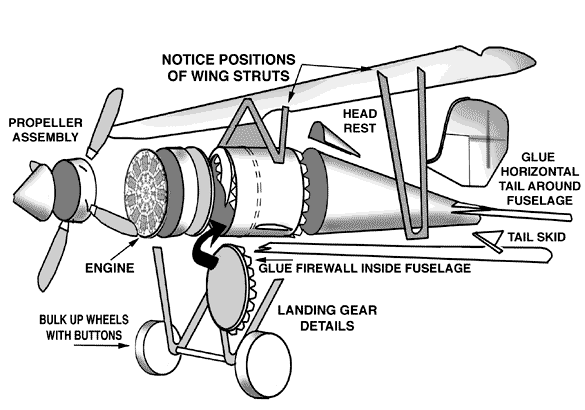
Specifications of the Siemens-Schuckert D-IV
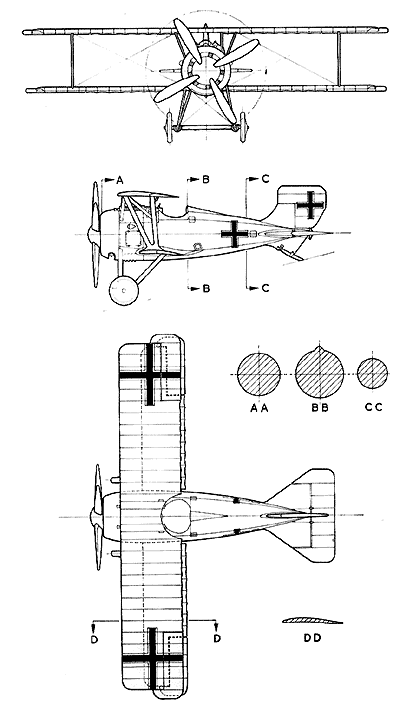 |
Length: 18 ft 8½ in Wingspan: 27 ft 7? in Height: 8 ft 11 in Wing area: 163 ft² Empty weight: 1,190 lb Loaded weight: 1,620 lb Powerplant: 1× Siemens-Halske Sh.III 11-cylinder geared rotary engine, 60 PS Performance Maximum speed: 119 mph Service ceiling: 26,200 ft Wing loading: 9.94 lb/ft² Power/mass: 0.099 PS/lb Endurance: 2 hours Climb to 3,300 ft: 1.9 min Climb to 19,700 ft: 15.5 min Armament 2 × 7.92 mm (0.31 in) LMG 08/15 machine guns |


